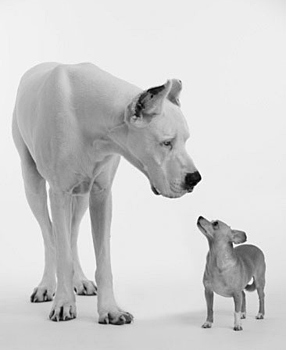
In Brief
Dog almighty
Canine clues help Macarthur ‘genius’ sniff out medically important genes
Photo by JamanaImagesRF
Sure, dogs are special. You might not be aware, however, that knowledge of their genomes can lead to advances in human health.
So next time you gaze soulfully into a dog’s eyes, take note of the length of its nose or the size of its body. Although such attributes can vary wildly among different breeds — in fact, the dog is the most physically variable land animal — a team of investigators has discovered that just a few genetic regions determine dogs’ shapes.
In humans, such traits as body weight and height are usually influenced by the net impact of hundreds if not thousands of different genes, says co-senior author Carlos Bustamante, PhD, professor of genetics at Stanford and recipient of a 2010 MacArthur “genius grant” fellowship. Some of those genes play a bigger role than others, yet no one knows which. But now that Bustamante and his co-authors have identified the relatively few chromosome regions that control dogs’ basic physical attributes, they can look for the genetic counterparts in humans — the genes likely to be key for determining our health and physiques.
The research, published in the Aug. 10 Public Library of Science-Biology, is a product of the CanMap project, a collaborative effort at several institutions to gather genetic information from dogs for research.
The new findings result from the most comprehensive genetic analysis of dogs to date, based on the genotypes of more than 900 individual dogs. The researchers used 57 traits that visually differentiate one breed from another, including body size, snout length and ear type (upright versus floppy). Then they identified what regions of the dog genome contributed to each of these different characteristics — and found that just a few did most of the job. Take height and weight:
“We’ve found that only six or seven locations in the dog genome are necessary to explain about 80 percent of the differences in height and weight among dog breeds,” says Bustamante. His collaborators were at the National Human Genome Research Institute, Cornell University, the University of California-Los Angeles and Stanford.
In the future, the researchers plan to investigate whether dog behavioral traits can be linked to specific genomic regions and, if so, how these genes affect our own behavior.
— Krista Conger


